Meet the Family
Through their philanthropy, activism, and patronage of the arts, the Ewings and Julia Fairfax Hodge left a lasting impact on the Bloomington-Normal community and beyond.
Hazle Buck Ewing
(1880-1969)
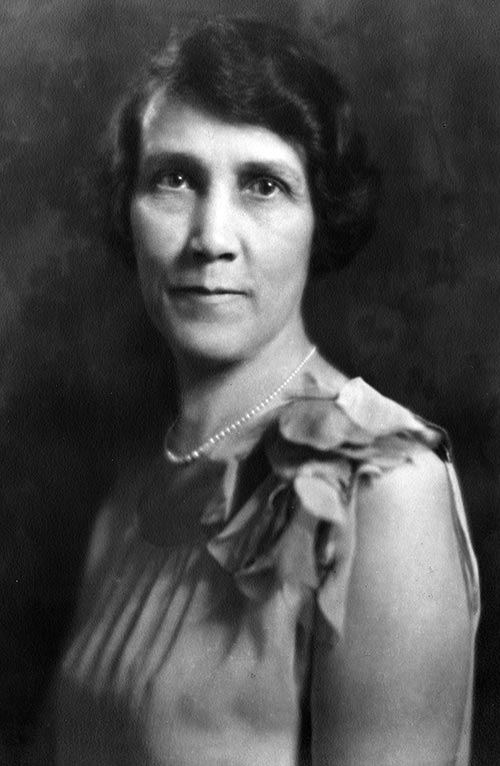
Lillian Hazle was born on December 25, 1880 to Orlando J. and Lillian Louise (Brewer) Buck of Cleveland, Ohio. She used her middle name, Hazle, to differentiate herself from her mother. Hazle’s father had made his fortune as a partner and stockholder of the Wrigley chewing gum company. A few weeks after her birth the family moved to the Auburn Park neighborhood of Chicago, Illinois. Hazle attended the University of Chicago, receiving a bachelor’s degree in philosophy in 1902.
Three years later she met Davis Ewing at a Christian Science meeting in Chicago. Hazle and Davis were married in 1907, whereupon she moved with him to his hometown of Bloomington, Illinois. Over the coming decades, her activism and philanthropy would come to transform the town. She contributed her time and money to many causes over her life, with a special focus on improving the conditions of women, children, animals, and natural spaces.
One of Hazle’s first projects was helping to secure women the right to vote, which she undertook with her customary zeal, writing copious letters to lawmakers, planning conferences, and even picketing the White House. At about the same time, she started a campaign to raise funds for a Bloomington-based refuge for boys from troubled families. Hazle eventually succeeded in gathering enough funds for a down payment on a large house, and the facility, named Victory Hall in honor of the end of World War I, opened its doors in 1919. Four years later, she brought a young boy named Nelson home from the Hall to live with her and Davis. While he could never be formally adopted, they were able to change his last name to Ewing in 1924.
Between 1924 and 1925, Hazle, Davis, and their older adopted son, Ralph, embarked on a 13½-month world tour, visiting 15 countries on four continents. This experience proved lifechanging for the family and sparked Hazle’s interest in international affairs and promoting world peace. She would later establish the School of Nations at Principia College in Elsah, Illinois, which provided funds for internationally-focused curricula, exchange students, visiting lecturers, and faculty. The trip also served as the inspiration for the unique architecture of Sunset Hill, Hazle’s home from the age of 49 until her death in 1969.
Soon after moving in to Sunset Hill, Hazle and Davis divorced and Julia Fairfax Hodge joined her in the home as her companion. For several decades afterwards they continued to volunteer, host social gatherings, and travel together. A lifelong horsewoman, Hazle often took them to the Buck family’s Thunder Mountain Ranch in Crivitz, Wisconsin.
In later years, Hazle’s philanthropy only increased. She donated some 10 acres of land to the city of Bloomington in 1956 to create what are now the three Ewing Parks. In 1960, she funded the repair of a stone arch bridge at Miller Park and later created a foundation to buy animals for the Miller Park Zoo. Three years later she supplied the seed money to launch Illinois Wesleyan University’s School of Nursing. Hazle’s will included several generous charitable bequests, including the donation of 160 acres of land to the State of Illinois for the conservation of native prairies, and her own home and its grounds to the Illinois State University Foundation with the aim of establishing a Ewing Museum of Nations to display the many international object d’art she had collected on her travels.
Davis Weldon Ewing
(1876-1972)
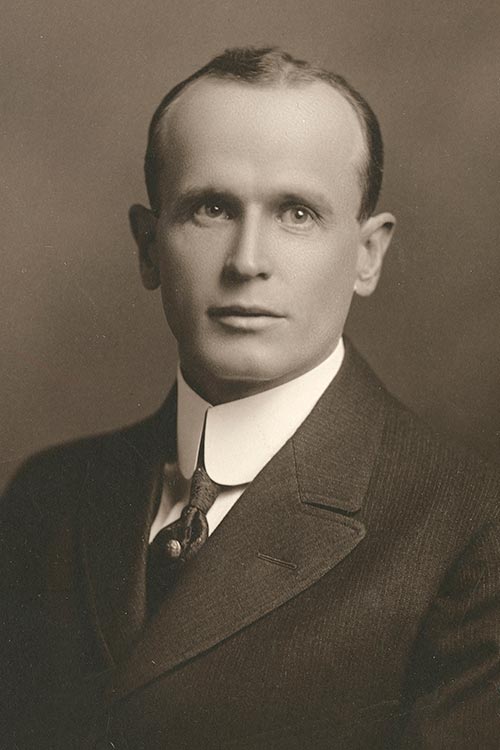
Davis was born on July 21, 1876 to James Stevenson and Katherine (Spencer) Ewing of Bloomington, Illinois. As a teen, he lived for several years in Belgium with his family after his father, a cousin to Adlai Stevenson, received an appointment from President Grover Cleveland to serve as a diplomat to that country in 1893. Upon returning the to the United States, Davis began working for Barber Asphalt Paving Co. in Chicago at the age of 19. Four years later, he moved west to receive training in mine management and oversee an Idaho gold mine owned by relatives. With the knowledge he gained from that experience, Davis returned to Illinois in 1900 to serve as receiver to the bankrupt East Coal Company in Colfax after it had been foreclosed upon by his father.
In 1905 Davis met 24-year-old Hazle Buck on a trip to Chicago; the couple were married two years later, soon after the founding of the Davis Ewing Concrete Company in Bloomington. Initially specializing in poured sidewalks, the company later pivoted to focus on fence posts, building blocks, and corncribs. A dedicated patron of the arts, Davis helped found the Community Players Theatre in 1923 and served as president of the Bloomington-Normal Art Association from 1922-1924.
During their marriage, the Ewings raised two boys. Ralph came to live with them at their home on East Olive Street in about 1914 and Nelson arrived nine years later in 1923. Davis, Hazle, and Nelson spent 13½ months traveling around the world between 1924 and 1925 – the experience proved life-changing for the family and inspired the architecture of Sunset Hill, a Channel Norman-style manor Davis commissioned to be built in 1928. Davis and Hazle separated six months after moving in and divorced in December 1931, when Davis was 55. He subsequently sold his concrete company and moved to Algonquin, Illinois, where he married Meta “Margery” Hunt (née Niemeyer). They retired to Mt. Dora, Florida in the 1950s.
Julia Fairfax Hodge
(1878-1966)
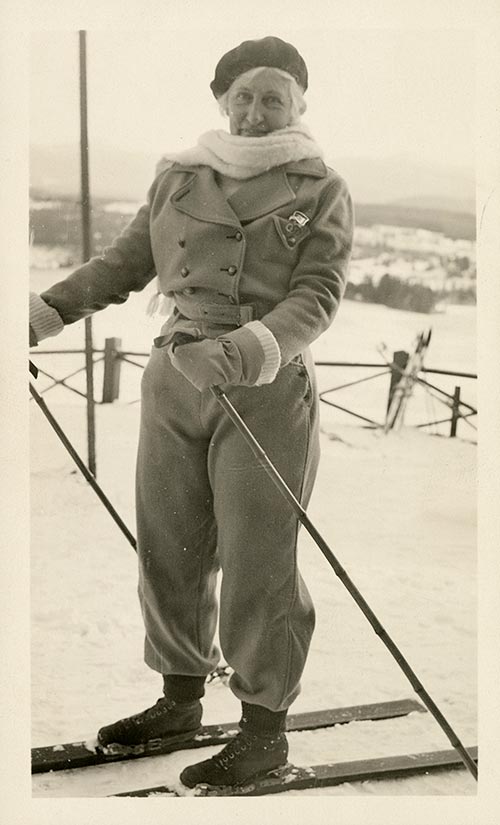
Julia was born on September 14, 1878 to Uriah and Mary (Clark) Hodge of Danvers, Illinois. She attended Illinois Wesleyan Preparatory School in Bloomington, Illinois from 1895-1896, followed by a stint at Washington University in Seattle, Washington.
Julia served as a Red Cross worker during World War I and World War II. From 1926-1931 she kept an apartment in Paris which she treated as home base during her travels throughout Europe and beyond. She and Hazle, who had long moved in the same circles as Central Illinois women of independent means, embarked on a cross-country trip together during the summer of 1930. Julia moved in with Hazle at Sunset Hill soon after the latter’s separation from Davis in 1930. As Hazle’s companion, she came to be known as “Cousin Julia” by the Ewings and served as co-hostess for many social events at the manor over the following decades. When not traveling with Hazle or on her own, Julia also helped maintain the household and take care of Nelson during his visits from school.
Like Hazle, Julia was known for her community activism. Over the years she volunteered with a number of local arts and charity organizations, including Victory Hall, Red Cross, Community Players, History Club, League of Women Voters, American Association for the United Nations and the Bloomington-Normal Art Association. At the time of her death in 1966, she and Hazle had been companions for 34 years.
William Gillespie “Whig” Ewing
(1839-1922)
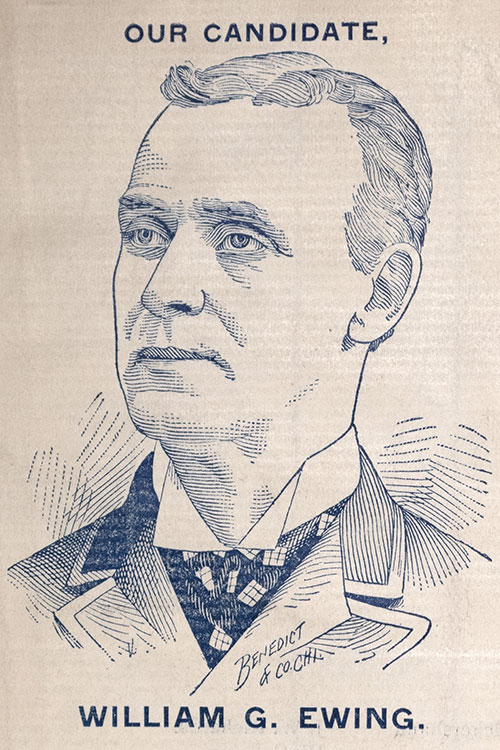
William “Whig” Ewing was Davis Ewing’s uncle – specifically, Davis’ father James Stevenson Ewing’s (1835-1918) younger brother. Their parents were John Wallis Ewing (1808-1855) and Maria McClelland Ewing, née Stevenson (1802-1883). Together John and Maria had six children who survived infancy, including five boys and one girl. According to an oft-repeated tale, the family received a visit from their friend Abraham Lincoln when the children were young during which Lincoln, at the time a member of the Whig Party, exclaimed, “Don’t let all these fine boys grow up to be Democrats. Let me make a Whig of one of them.” William, selected in that moment as the future Whig, proudly wore the nickname for the rest of his life.
Most of the Ewing children, including William, were born on a farm in what is now rural Woodford County, Illinois. The family relocated to nearby Bloomington in 1841, and John served as the city’s fourth mayor from 1854-1855. Following a basic education in the local school system, William studied at Bloomington’s Illinois Wesleyan University and was awarded a teaching certificate by the McLean County school commissioner in 1858. After a short stint teaching in a rural district near Hopkinsville, Kentucky, he returned to Bloomington to study law with local attorney Robert E. Williams. Upon his admittance to the Illinois Bar Association in 1861, he decamped to nearby Metamora to hang his shingle. William married Ruth Goodrich Babcock of that city in 1865. The couple soon after moved to Quincy, where he would for the next 19 years serve the region in multiple prominent positions, including as superintendent of schools, city attorney, and state’s attorney for the 15th judicial circuit. There he gained a reputation as a capable prosecutor and investigator while trying several high-profile criminal cases, including the Ballew murder trial in 1870. During their time in Quincy, William and Ruth had two daughters, Mary and Ruth.
In 1882, the family moved to Chicago where William set up a new law firm with his youngest brother Adlai. Just two years later, William’s health had deteriorated to the point that felt himself to be “in the very gloom and shadow of the grave” due to a debilitating lung ailment – possibly pulmonary tuberculosis – prompting him to seek solace in the supposedly healthful airs of the Western United States. William’s search for a cure eventually led him to a Boston-based practitioner of Christian Science, an emerging faith founded in New England whose followers believed in the healing power of prayer. After experiencing a near total remission of his condition, William later converted to Christian Science, as did his wife, daughters, brother Adlai, and sister-in-law Kate Hyde Ewing.
William, James, and their cousin Adlai Stevenson I were all early and dedicated boosters of Grover Cleveland’s 1884 and 1892 presidential campaigns. During Cleveland’s two terms in office, they all received prominent political posts. William’s recognition came in the form of an 1886 appointment as federal judge for the Northern District of Illinois. In 1890 William unsuccessfully ran for Congress as representative of Illinois’ first district, followed by a successful bid for the position of Cook County superior court judge in 1892.
Seven years into his term, William left his judgeship, having been persuaded by Christian Science founder Mary Baker Eddy to become her “lecturer laureate.” In that capacity he traveled extensively throughout the United States and even internationally to expound upon the tenants of their shared faith. Finally, in 1910, the former judge retired from the church’s Board of Lectureship. He lived out the rest of his life in Deerfield, a Northern suburb of Chicago, with his wife and adult daughters, dying at the age of 82.
The William Ewing Collection was donated to Ewing Cultural Center by descendants of William’s brother Adlai in 2025.
Ralph Nelson Ewing
(1907-1981)
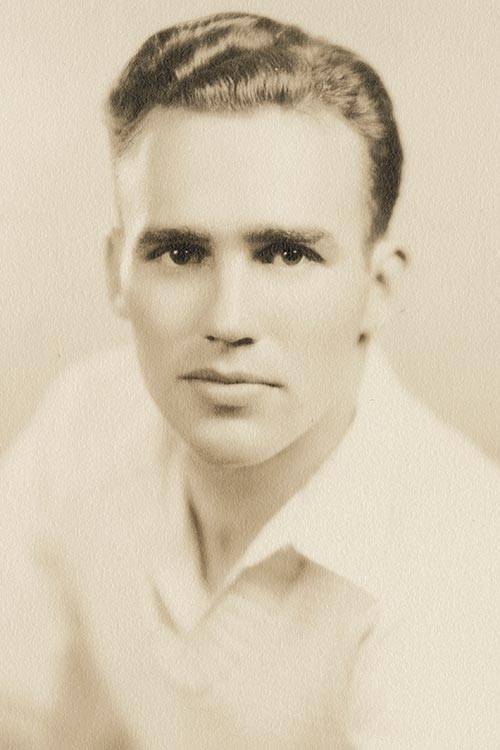
Ralph came to live with Davis and Hazle when he was about 7 years old and was formally adopted by them in 1917. As a teen, he attended Principia Preparatory School in St. Louis, Missouri, graduating in June 1924. The following August, he and his parents embarked on a 13½ month-long world tour, a lifechanging experience for the family. Upon their return, Ralph enrolled in Rollins College in Winter Park, Florida, where he was active in dramatics. He never selected a major and left in 1929.
That same year, Ralph moved to St. Louis, Missouri and began working as a manager at Garland’s, a high-end women’s clothing shop. By early 1932 he had returned to Bloomington and in January 1933 started work at a downtown “women’s ready to wear establishment” called Style Mart. Three years later he returned to St. Louis to assume a position at Stix Baer and Fuller department store. There he met Kate Lee Culbertson, a supervisor in the personnel department. The couple were married on February 20, 1937 in front of the fireplace at Sunset Hill.
In 1938 they moved to Kate Lee’s hometown of Russell, Kansas, where Ralph found work at the L. Banker Mercantile Co. Ralph and Kate Lee’s only child Lucinda “Cindy” Buck Ewing was born three years later. For two years during World War II Ralph served as a private in the U.S. Army. In 1947 he won the first of two elections to serve as Russell County Clerk. In later years he was employed by the State of Kansas’ Tax Department. After his mother’s death in 1969, Ralph joined the Illinois State University Foundation’s Board of Directors. He also a member of the Friends of Milner Library from the early 1970s until his death in 1981.
Nelson Ewing
(1917-2001)
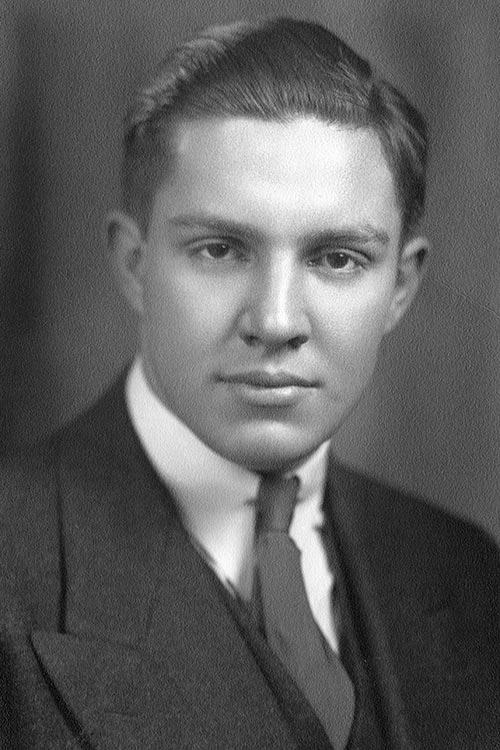
Nelson was born in Sioux Falls, South Dakota. As a young child, he lived at Victory Hall in Bloomington, a home for boys whose families couldn’t care for them. Hazle had helped found the organization and served for many years on its board of directors. She and Davis brought six-year-old Nelson to live with them in 1923 and legally changed his last name to Ewing the following year, though he was never formally adopted. From the age of thirteen Nelson spent nine months out of the year at boarding schools, first Principia Preparatory in St. Louis, Missouri and later Cranbook in Bloomfield Hills, Michigan, where he studied design. As a teen he also apprenticed under Bloomington jeweler Jack Lewis and received instruction in gold and silver artcraft from Pasadena, California-based jewelry maker James L. Winn shortly before the latter’s death in 1935. After graduating from Cranbrook, Nelson went on to pursue a Bachelor of Arts degree from Washington University in St. Louis, as well as study design and engineering at the Illinois Institute of Technology.
Nelson began working in the machine design department of the Wrigley Company in Chicago in 1939. Two years later, on May 3, 1941, he married 21-year-old stenographer and McLean, Illinois native Emily June Bode. The couple settled on the north side of Chicago. They would go on to have four children together: Theodore, Sandra, Phillip, and Davis.
By 1955, Nelson had become director of design for Elgin National Watch Company in Elgin, Illinois. In that position he was responsible for the creation of an adjustable watchband, as well as innovations in advertising and packaging. He moved his family to Hampton, New Hampshire in 1961 and then to Newburyport, Massachusetts in 1965, where he took a job working for Towle Silver. In 1968 the family resettled a final time in Tucson, Arizona. There, Nelson and his children opened Ewing Jewelers International, a small shop offering imports, Native American designs, and custom-made jewelry. In 1972 they changed the name to Ewing Jeweler of Nations, Inc. The store’s closure in the early 1980s coincided with Nelson’s retirement.